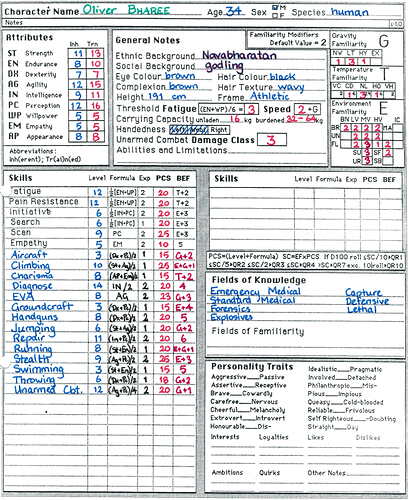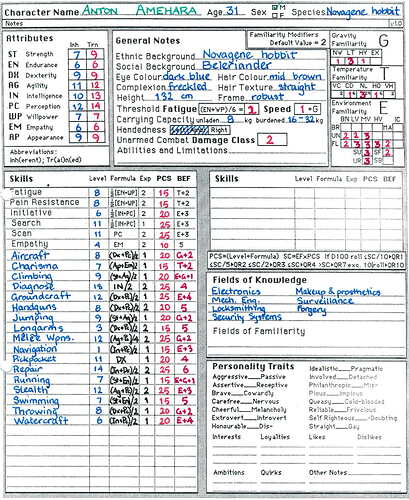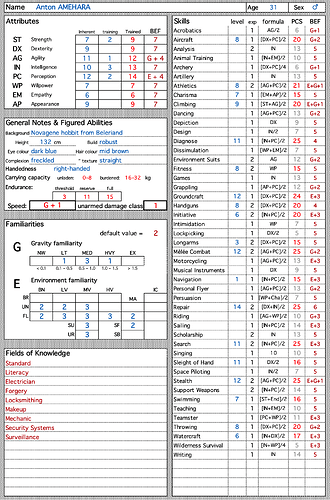At long last I have faced up to the reality that I can’t run ongoing campaigns in my current circumstances, and I have reconciled (or perhaps resigned) myself to running sporadic one-and-done adventures for scratch groups. Having players [learn a system and] generate their own characters ahead of (or worse, during) a single session makes the start-up investment more than the game will justify. So I am generating a stable of suitable characters for the scratch groups to pick a scratch parties from among. The idea is that three or perhaps four character players will be able to choose characters from the stable without anyone getting stuck with Hobson’s choice, and that the characters chosen will have among them such a collection of capabilities that the party will be able to complete one of my sci-fi thriller/mystery adventures. I am not clever enough to contrive such as stable that any three or four characters chosen will constitute a workable party; there must be restrictions such as “only one of this subset” or “one each from these subsets” to ensure niche protection and overall party competence. I just don’t want any player to be stuck with no significant choice.
Each instance of the party will be a somewhat different version of a team of effectives working for one of the interstellar non-government organisations in my setting Flat Black . “Effectives” in this context are skilled and versatile field agents that interstellar NGOs send in to fix problems when their permanent local staff and affiliates lack very particular sets of skills, or lack the resolve to perform dangerous, strenuous missions, or the boldness to confront opposition. In short effectives are the non-government equivalent of clandestine operators.
I don’t plan adventures in the form of a series of events that will occur, nor even as a set of branching paths. Rather, I present the players with a situation including possible objectives, obstacles, and opposition. But the kind of objectives and opposition that I create for these mystery-thrillers often result in the PCs executing phases in which they
- investigate to work out specifically what needs to be done;
- find the location where the thing must be taken, put, replaced, examined, modified, or destroyed, or the person rescued, assassinated, treated, assisted, stopped, told, asked, or negotiated with;
- gain entry to a secure location;
- take, put, replace, install, modify, examine, or destroy a thing, or rescue, kill, treat, poison, assist, inform, ask, negotiate with, or arrest a person,
- escape or flee, and perhaps prevent or stop pursuit, and
- fight.
The party as a whole ought to have several ways to do each of those things, so as to be able to cope with varied challenges. To function as an effective, each character ought to be able to make at least some characteristic contribution to each of those phases, so that the character is not left out nor the player bored.
- An investigation phase might involve standard investigation methods (which is to say, methodical interviews), collection of physical evidence and its scientific examination, forensic analysis of financial records, formal research in libraries and record collects, obtaining and analysing security-camera recordings, placing and use of bugs and wiretaps (or their technological equivalents), stakeouts and surveillance, placing tracers for movement analysis, signals intelligence analysis, provoking people to behave in revealing ways, and provoking indiscreet revelations.
- A finding phase might involve shadowing or chasing a person or vehicle, hiding or placing tracers in vehicles and shipments, operating observation drones, obtaining and analysing intelligence (such as vehicle movements, distinctive purchases, the presence of distinctive people etc.) from human, observational, and open sources. It might involve eavesdropping, bugs, and wiretaps, and provoking indiscreet revelations. It might also involve use of dissimulation, persuasion, and seduction to trick a person into taking one to the secure location.
- Gaining entry to the secure location may involve classic second-storey work, in which a character uses stealth, climbing skills, and perhaps SCUBA, parawings, personal flyers etc. to access to a entrance that is under-secured because it seems inaccessible. It might involve old-fashioned housebreaking, in which a character uses construction equipment and reverse construction methods to create an entrance in an un-secured place. It might involve “physical penetration” methods of opening locked entrances with mechanical and electronic security. It might involve “social engineering” methods of tricking guards on entrances into allowing passage. It might involve impersonating a specific person authorised to enter, perhaps with a disguise, false IDs, and stolen or duplicated keys. It might involve using “cuckoo” interpersonal methods to trick or persuade a person with appropriate authority to grant entry or take one in.
- Doing the thing in the place might involve safecracking, or computer security cracking, and perhaps even research or accounting skills to take, place, replace, modify, or examine valuables and records. It might involve electrical, mechanical, and construction skills to install or disable rigs, and it might involve knowledge of arson, firebombs, and explosives either to destroy or prevent the destruction of the facility. It might involve the skills of a wet-worker, muscle, or medic to kill, coerce, or interrogate a person, or the skills of a physician to treat, drug, or poison one. It might involve interpersonal skills to inform or persuade a person. It might involve using forensic science abilities to examine, modify, or fake a crime scene.
- Escaping and fleeing generally involves vehicles skills: aircraft, groundcraft, and watercraft. With a party of generally only three or four characters, a single getaway driver or pilot will do for all, whereas an escape on individual vehicles (mounts, motorcycles, personal fliers) or foot would require all the characters to be adept at running and cross-country hiking. While one character is driving the getaway vehicle, the others might perhaps navigate, shoot at pursuers, ambushers, and roadblocks, or deploy rigs in the vehicle or at prepared points on the prepared escape route to stop, misdirect, or confuse pursuers.
- RPGs tend to make fighting critical and time-consuming, so it’s a danger to leave any character out. Besides which, having to fight is a failure mode that can crop up in anybody’s plan. All effectives (at least, all effectives who are PCs) ought to be able to at least fight their way out of either a firefight or a fistfight. So every PC needs workmanlike skill with handguns and in unarmed combat, and every party needs at least one muscle or wet worker who can end a fight quickly and let the party force its way past minor opposition. Perhaps both are needed.
The particular team that comprises the party in any of these adventures will be one that is accustomed to working under cover as a production crew for reality video content for streaming on internet-like services on rich Core worlds. In short, the party will be non-government clandestine operators under cover as Youtubers. Their cover will be that they visit exotic planets ostensibly to create content, and each one will have an ostensible role in the film crew that accounts for their appearance, apparent abilities, and some of their activities, and that provides a plausible pretext for having and travelling with equipment and supplies that can be used in clandestine operations.
I have the following characters in mind to generate, conceived as combinations of their cover roles, their roles in effectuations, and their capabilities. I should welcome suggestions and comments.
THE CAMERA OPERATOR
The camera operator is expert at controlling drones and probes, remote surveillance, wiretaps and wireless signal interception and falsification, and circumventing electronic locks and security systems. Dextrous and perceptive, he or she is also a marksman, driver, and pavement artist (i.e. skilled at watching and following people in public).
{NBA: Watcher, Wheel Artist, Wet Worker (sniper), Wire Rat.}
THE KEY SCENIC AND PRACTICAL-EFFECTS TECHNICIAN
The key scenic builds sets, rigs lights and cameras, and designs and builds practical-effects rigs including pyrotechnics — he or she has in short a broad suite of engineering and maker skills that can at need be used to un-make things. Dextrous and intelligent, he or she is also a good driver and shot, and a surprisingly good actor.
{NBA: Cuckoo, Wet Worker, Wheel Artist, Wire Rat}
THE LOCATION MANAGER
The location manager has expert scouting and research skills, is persuasive and an excellent impersonator, and is a skilled pavement artist. He or she can find information, anomalies, and supplies through both electronic and human networks.
{NBA: Analyst, Asset Handler, Cuckoo, Investigator, Watcher, Wet Worker (sniper)}
THE MAKEUP AND COSTUME ARTIST #1
The makeup and costume artist makes disguises, including forged credentials, and duplicated keys, not only for herself but also for other characters. Dextrous and perceptive, she is a capable getaway driver, a crack shot, and an expert pavement artist. Owing to the way that people were made on Esbouvier when she was “born”, she is middling height, of a medium androgynous build, and lacks secondary sexual characteristics. With prosthetic breasts she can pass for a (non-Esbouvieri) woman; with a Willie™ prosthesis (which combines the functions of a stand-to-pee device, a packer, and an adhesive dildo, with lifelike appearance) she can pass for a man — even nude.
{NBA: Cobbler, Cuckoo, Watcher, Wheel Artist}
THE MAKEUP AND COSTUME ARTIST #2
The makeup and costume artist makes disguises, including forged credentials, and duplicated keys. He or she also picks locks and cracks safes, plants and finds bugs and other hidden things, drives vehicles, and is a workmanlike second-storey worker. A Novagene hobbit from Beleriand, the makeup artist is 149 cm tall and can pass for a child (or, with prostheses, a hypochondroplasic dwarf)…
{NBA: Black Bagger, Cobbler, Mule, Wheel Artist}
THE MEDIC
The medic is a forensic pathologist and emergency medicine specialist who is able to pick locks and willing to kill people. He or she is also a competent dissimulator, and good-looking enough to present either as eye candy or a groupie when it is not plausible that the team needs a doctor.
{NBA: Cuckoo, Medic, Swallow, Wet Worker (CQB)}
THE PRODUCTION MANAGER
The production manager is a forensic accountant and experienced investigator, with research, analysis, and interview skills. He or she has interpersonal skills that include bribery, blackmail, and coercion, can crack computer security, and is brutally effective in hand-to-hand combat.
{NBA: Analyst, Asset Handler, Bagman, Cuckoo, Hacker, Muscle}
THE TALENT #1 (the extreme sports star)
The sports extremist performs spectacular stunts to be filmed in exotic locations — BASE jumping, free climbing, paragliding, parkour, mountaineering, spelunking, SCUBA diving — and goes to inaccessible places to be filmed in spectacular settings. Agile and strong, he or she makes effective muscle. Good-looking and articulate to address the camera, he or she can do interviews, and with some pretensions to celebrity he or she can function as cuckoo. The sports extremist is expert with watercraft.
{NBA: Black Bagger, Cuckoo, Muscle, Wheel Artist (boats)}
THE TALENT #2 (the industrial archeologist)
The industrial archaeologist fronts videos exploring and explaining remarkable structures, engineering works, landforms, and planetological features that presented unique opportunities and challenges to the pioneers of the planet. A versatile engineer, the archaeologist can do physical penetration, make and instal rigs, operate construction equipment for forced entries, set incendiaries and explosives, and pick locks and crack safes. He or she is also a crack shot.
{NBA: Black Bagger, Bang & Burner, Cobbler, Wet Worker, Wheel Artist, Wire Rat}
THE TALENT #3 (the participant ethnographer)
The participant ethnographer produces ethnographic exploitation material for video streaming, taking part in ceremonies, celebrations, and cultural experiences to be filmed. Expertise in anthropology and social psychology combined with looks and social intelligence make him or her an expert manipulator, cuckoo, and (at the player’s discretion) swallow, good at discerning relationships and eliciting indiscretions. The ethnographer is a capable researcher and interviewer, trained in planting and discovering hidden listening devices and cameras, and can crack computer security.
{NBA: Asset Handler, Cuckoo, Hacker, Investigator, Swallow}
{I put rough equivalents in the terms used in Night’s Black Agents after each character description for a guide. They are only rough indications. In some cases I refer to limited special cases of the NBA backgrounds.}
Since the Talent’s activity in front of the camera determines where the crew goes and what it does, only one “Talent” character ought to be played in any version of the team. Similarly, including both Costume & Makeup artists would be redundant, and other pairs of sets of characters overlap at least a bit (such as the industrial archaeologist and the key scenic and practical effects technician). Still, I think there is enough variety there that three or four players ought to be able to put together a workable team without anyone having not real choice of character.
Most of these characters can be played as being any sex, gender, or orientation at the players’ choice, except for the costume & wardrobe artist #1. The characters would have to be willing to affect various presentations on ops.
I don’t run assassination plots, so it wouldn’t matter if a player wanted to tone one of these characters down to a person who doesn’t kill in cold blood. It would be up to any player whether their character was a “full contact” interpersonal character, and whether or not he or she was prepared to engage in sexual activity contrary to their orientation, for operational purposes.
I have doubtless committed blunders and oversights in the material above, and would be pleased if you were to point them out before I commit to pretty much a whole day of character generation.


